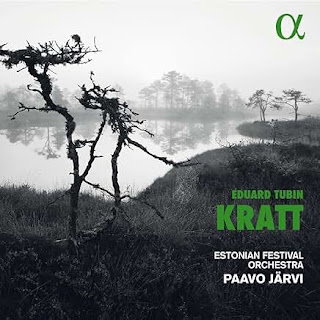by Karl Nehring
Estonian Festival Orchestra; Paavo Järvi, conductor. Alpha Classics ALPHA 1006
With apologies to Alpha Classics, I still can’t help but think of this as a Telarc release; it just looks, feels, and sounds like the kind of the kind of recording that the Estonian conductor Paavo Järvi (b. 1962) used to release on the late, lamented Cleveland-based audiophile label back when he was at the helm of the Cincinnati Symphony Orchestra from 2001-2011. He released a boatload of recordings with the CSO on Telarc, and most of them were excellent. Since then, he has made a number of fine recordings with other orchestras for other labels, including a number of notable recordings of symphonies by Beethoven and Bruckner for RCA. But here we have him presenting some music by some lesser-known composers: two pieces by the Estonian composer Eduard Tubin (1905-1982) along with one each by the Polish composers Grażyna Bacewicz (1909-1969) and Witold Lutoslawski (1913-1994).
As you can see from a glance at the cover, Tubin’s Kratt Suite is the featured composition on this album. Of the four compositions on the program, it is the only one for full orchestra; the others are for strings only. According to the liner notes, “In Estonian mythology, a kratt (goblin) is created by man but brought to life by the Devil. Influenced by evil forces, a kratt flies through the air, leaving a torrid trail of fire in his wake as he gathers riches for his master. But with that, the master sells his soul to the Devil… In 1961, Tubin composed the Suite from the ballet Kratt commissioned by the Swedish Radio Symphony Orchestra. Rich in contrasts, the work contains colourful imagery from ballet music, folk tunes and influences from Stravinsky to Bartók. As in many other compositions by Tubin, the piece combines folk music with modern means of expression.” (In case you might be wondering why the commission came from a Swedish orchestra, it was because as a result of WWII, in 1944 Tubin was forced to flee Estonia for Sweden, where he wound up living for the remainder of his life.)
Typical of a score based on a ballet, the music is episodic, shifting in tempo and mood as it moves from scene to scene. As presented on this CD, the Suite is divided into three tracks, each including scenes described and follows: I. Introduction / Peasant Dance / Dance of the Goblin (5:03); II. Long Dance / Peasant Waltz / Buck Dance (6:52); III. Interlude / Dance of the Exorcists / The Goat / The Cock / Dance of the Northern Lights (11:41). It’s a lively, colorful piece, of course infused with dance rhythms throughout. It’s not as savage as The Rite of Spring or as dramatic as The Firebird, but is more charming than either of those two more well-known ballet scores.
Perhaps it would have been better to have programmed Kratt as the final rather than first work on the disc, because following such a colorfully scored work for full orchestra with three works for strings only has its disadvantages. That is not to say they are inferior compositions, however. Bacewicz’s Concerto for String Orchestra is said to be inspired by Bartók’s Concerto for Orchestra in that it focuses on several solo parts rather than one soloist – and of course her work is for strings only, not full orchestra. It is energetic and involving, with a third movement marked Vivo that sweeps along with controlled frenzy. But then we come to the first movement of Tubin’s Music for Strings, marked Moderato, and unless we are paying careful attention to the track numbers, we might think we are listening to another movement by Bacewicz. That’s not a criticism of Tubin’s music; rather, it’s an example of what I find to be a problem with this release – that the three compositions for strings seem to blend into one another.
In any event, Tubin’s three-movement Music for Strings, which sounds more formal, less expressive than his music from Kratt, is followed by Lutoslawski’s Musique Funèbre, which he composed in memory of Bela Bartók. According to the liner notes, “for Lutoslawski, Bartók was the only composer among his contemporaries who was able to reach the heights of Beethoven’s ideals.” It is an intense work in four movements, dark and brooding, yet possessed of an inevitable sense of motion and purpose. The final measures find the music fading into nothingness to chilling effect, ending the work – and the CD – not with a bang, but a whisper. Although it is a relatively brief piece, it packs an emotional wallop.
Although the second Tubin piece seems to get lost in the shuffle, and the program seems unbalanced with an orchestral piece followed by three string pieces, the first Tubin (Kratt Suite), the Bacewicz, and the Lutoslawski are all rewarding listening. If you are looking for some music a bit off the beaten path but still rooted in the familiar, this album is well worth an audition.




Grateful for your commitment to quality content. Your post was excellent.
ReplyDeleteThank you for the kind words. We try our best to share our love for music and pass along or recommendations of recordings that we find noteworthy. - KN
ReplyDelete